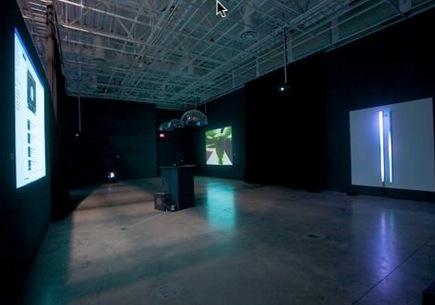
LIVE
What is the meaning of "live" when the majority of our day-to-day interactions are so mediated? LIVE features nine artists who sample and transform data, photographs and video from the Internet and incorporate it into their sculptures and installations. Either extracting live footage or transmitting data in real time, they cull from diverse sources including Congressional speeches from C-Span, websites with Iraqi war casualties, a critique of consumerism from a peer-to-peer network and on-line video surveillance. As the artists isolate ideas and images from the steady stream of unrelenting data, they produce thought-provoking, aesthetic and "live" works of art. Curated by David Familian, includes Radical Software Group (Alexander R. Galloway) and MTAA (Mike Sarff & Tim Whidden), Natalie Bookchin, Aphid Stern, Michael Dale, Karen Finley, Siebren Versteeg, Ben Rubin.
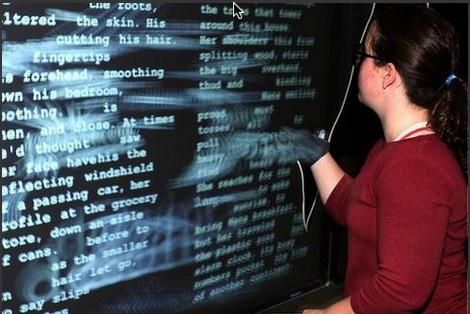
GrandTextAuto
What happens when a popular blog crashes into a gallery exhibition? Jump in as the drivers of Grand Text Auto careen toward new fictional forms and modes of play. Grand Text Auto presents six artists wheeling their way to the forefront of digital games and narrative. The artists include Noah Wardrip-Fruin, Mary Flanagan, Michael Mateas, Andrew Stern, Nick Montfort, and Scott Rettberg. With collaboration and support from the GVU Center at the Georgia Institute of Technology and the Center for Research in Computing and the Arts at the University of California, San Diego.
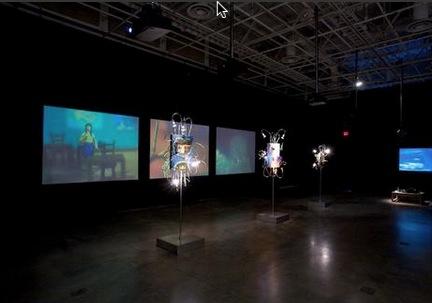
Jennifer & Kevin McCoy: Constant World
Known for their intricate and intimate dioramas featuring small spy cameras that project scenes onto walls, monitors, or screens, the McCoys explore a wide range of topics, ranging from the personal to the political. The exhibition demonstrates their continuing interest in sculpture, cinema and technology, and features the U.S. premiere of Constant World, a major work commissioned by the British Film Institute, as well as a survey of recent works.
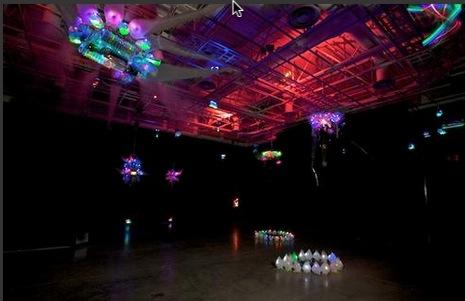
Shih Chieh Huang: Project EX-I-09
Project EX-I-09 focuses on exploring the unusual evolutionary adaptations undertaken by creatures that reside in inhospitable conditions. I create analogous ecosystems in my installations and populate them with organic living things made from common,everyday objects. I source my wholly synthetic materials from the mundane objects that comprise our modern existence: household appliances, zip ties, water tubes, lights, computer parts, motorized toys and the like. The objects are dissected and disassembled as needed and reconstructed into experimental primitive organisms that reside on the fringes of evolutionary transformation: computer cooling fans are repurposed for loco- motion; Tupperware serves as a skeletal framework; guitar tuner rewired to detect sound; and automatic night lights become a sensory input.
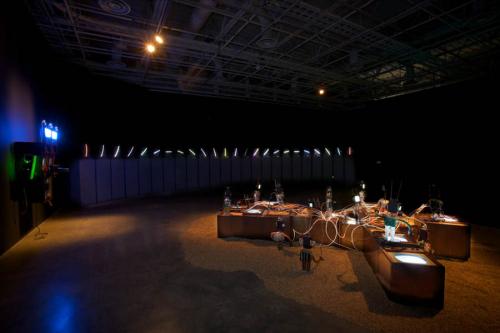
Media Alchemy of Nam June Paik
Paik’s career started with his association with Fluxus, most notably his performances, in the early 60’s. In 1964, Paik collaborated with classical cellist Charlotte Moorman to create TV Cello, where they stacked televisions on top of one another to form the shape of an actual cello. When Moorman drew her bow across the "cello," images of both her playing and images of other cellists playing appeared on the screens. This became the major aspect of Paik’s personal work - the TV cabinet as a sculptural element and the screen’s plastic qualities pushed to the limit. One of the ways he achieved this was by creating his own video synthesizer that enabled him to create the kind of generated images he wanted. The title for this exhibition, Media Alchemy of Nam June Paik, refers to an essay titled Video Alchemy by Lucio Cabuttiv. Paik truly was an alchemist combining various artistic forms and media technologies into groundbreaking bodies of work. Paik’s transformations explore the sculptural and screen elements of the television. His works were more centered on the television and its image than just the image on the screen. He never wanted us to forget “the box.” His sculptural/video approach would be one of the strong influences on future generations of artists creating video installations.
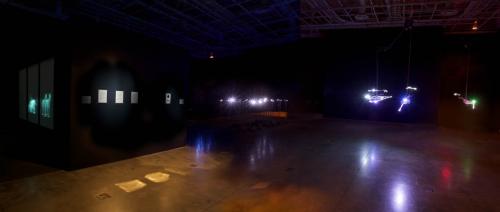
Emergence: Art and Artificial Life
Curated by David Familian and Simon Penny
Utilizing artificial intelligence and genetic programming techniques, custom electronics and robotics, Emergence features international artists representing the current state of work in the interdisciplinary field of art and artificial life. The interactive works in the exhibition include sculptural  and sound based works that utilize various forms of AI such as machine vision, semi-autonomous agents, genetic algorithms and cellular automata. The Beall Center exhibition includes Propagaciones by Leo Nuñez, a sculptural realization of one of the icons of artificial life, the cellular automaton; Marc Böhlen’s Universal Whistling Machine, which deploys AI techniques to present an amusing take on machine intelligence; Performative Ecologies, by Ruairi Glynn consisting of a trio of “dancing fools” - devices that seek to demonstrate the most pleasing dance they can devise; and Sniff by Karolina Sobecka, where a virtual dog interacts with viewers via machine vision. Each of these works offers an insight into a different dimension of Artificial Life Art.
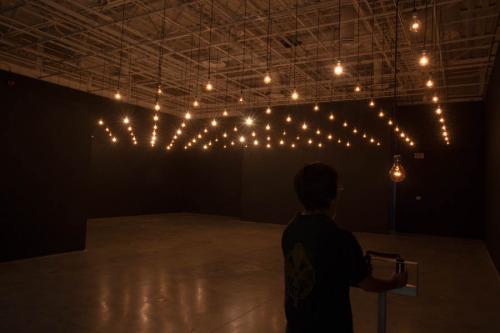
Pulse
The Beall exhibition will bring together three of Lozano-Hemmer’s recent installations that are part of a series of six works that use forms of biometric information, such as pulse and blood flow, to create forms of visual output. This exhibition offers a unique opportunity to see these works from this series together in one location. All three of the works combine multiple individual inputs in order to create a multivalent result. This is an ongoing thread within Hemmer’s work that explores various forms of embodied interactivity. The kinetic quality is not interactive in the traditional sense of the viewer consciously controlling the output. It is our autonomic nervous system systems, which we have less control that is made manifest by the work. That what is felt is made visible by the output of the work. By creating a representation of our pulse he not only reveals our own bodily function but that what we share with others. This transformation of control from our minds to our bodies is at the heart of Rafael Lozano-Hemmer’s work. Two of the works Pulse Room and Pulse Index presents us with a history of who has viewed the work in a kind of memento-mori, in Pulse Room we view blinking lights representing the last 100 viewers of the work and Pulse Index we see images of an index finger of the last 509 viewers.
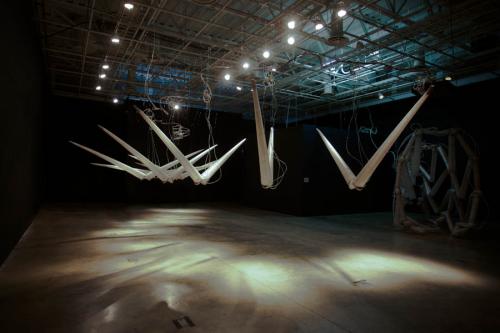
Chico MacMurtrie/Amorphic Robot Works: INFLATABLE BODIES
During the past twenty years MacMurtrie’s kinetic, monumental sculptural installations have evolved from different representations of the human body and various forms of nature into his current, more abstract works such as Inner Space, which is having its United States premiere in this exhibition. In his sculpture, MacMurtrie utilizes various technologies to create the illusion of a live object or living being: using computational mechanisms to achieve a very subtle level of control and movement.
Since 1994 MacMurtrie has created large-scale robotic installations and performances. His 20-meter-long Amorphic Landscape (2000) is an organic environment engineered to provide both a physical and narrative structure for more than 100 individual robots. This environment, however, is more than a passive context for its robotic inhabitants, The Landscape is, itself, a robotic form capable of movement and transformation. One-hour theatrical performances of The Landscape depict the formation of the earth, the birth and rise of creatures and communication, the degradation of the environment, and the many intervening life cycles in which everything takes part.
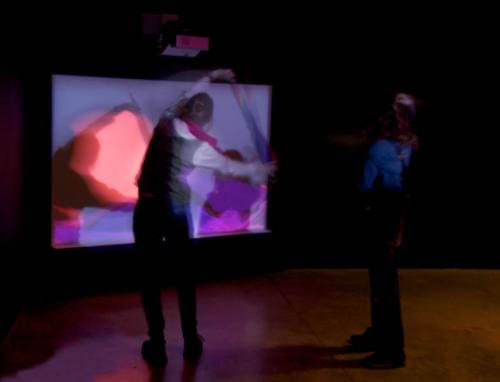
Golan Levin
For the past 15 years, Golan Levin’s artistic production has ranged from simple interactive works to more complex responsive sculptures and projections. He has pioneered new technologies, using his own computational methods to create life-like interactions with viewers of his work. He explores the formal and conceptual languages of interactivity, and nonverbal communications protocols in reactive systems. All of Levin’s work operates initially on the level of a mirror effect, enticing the viewer into a deeper engagement. For instance, his reactive sculptures like Opto-Isolator (2007) and Double-Taker (Snout) (2008) are eyeballs that follow the viewer, activated by their specific movements. His projections present whimsical and poetic responses to the viewers’ own sounds and gestures. The complex feedback systems in his works create a compelling array of kinetic and visual interactions.
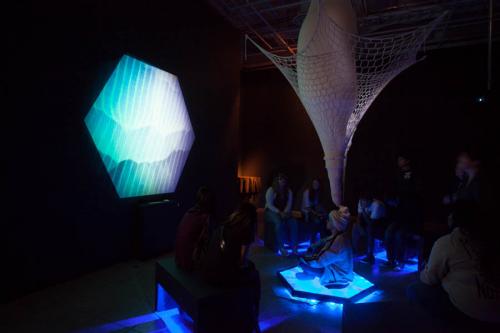
Victoria Vesna:MORPHONANO
MORPHONANO marks a decade of an artistic collaboration (2002-2012) of media artist Victoria Vesna and nanoscientist James Gimzewski. Their work is focused on the idea of change and consciousness at the intersection of space-time and embodiment. Participants interact with the works in mindful ways resulting in rich visual and sonic experiences within a meditative space. By reversing the scale of nanotechnology to the realm of human experience, the artist and scientist create a sublime reversal of space-time.
Victoria Vesna is a media artist and Professor at the Department of Design | Media Arts at the UCLA School of the Arts and director of the UCLA Art|Sci center. Her work can be defined as experimental creative research that resides between disciplines and technologies. She explores how communication technologies affect collective behavior and how perceptions of identity shift in relation to scientific innovation. Her most recent experiential installations -- Blue Morph, Water Bowls, Hox Zodiac, all aim to raise consciousness around environmental issues natural and human-animal relations. Other earlier notable works are Bodies INCorporated, Datamining Bodies, n0time and Cellular Trans_Actions.
James Gimzewski FRS is a distinguished Professor in the Dept. of Chemistry and Biochemistry at UCLA. He is director of Pico and Nano core laboratory at the California NanoSynstems Institute (CNSI). He is also scientific director of the Art | Sci center and a senior fellow of IMéRA. He pioneered research on electrical contact with single atoms and molecules, light emission and molecular imaging using STM. His accomplishments include the first STM-manipulation of molecules at room temperature, the realization of molecular abacus using buckyballs, the discovery of single molecule rotors and the development of nanomechanical sensors based on nanotechnology, which explore the ultimate limits of sensitivity and measurement.
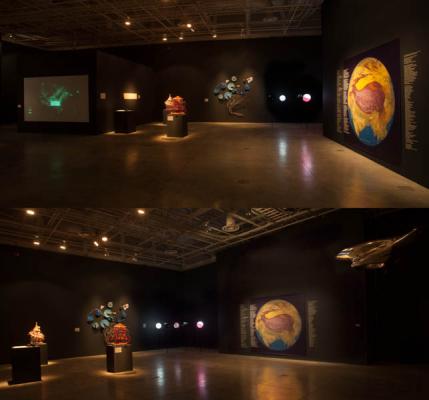 DataViz: Information as Art DataViz: Information as Art explores a wide range of practices that data artists and designers are currently using in their works including interactive dynamic images, sculptures and installations. DataViz goes beyond the simple notion of data visualizations, which tend to be represented by digital graphs or the representation of concepts in science. Through the confluence of science, technology and artistic practice, the works in this exhibition explore the deeper meanings of data revealing its beauty through several mediums. One aspect of the exhibition explores how the computational power of the computer has expanded the ability to display and continually update data as it changes in real time. By animating the shifts in data over time, instead of giving a static snapshot of a data set, we find more meaning in that data through the expansion of both the function and the reception of information. Other aspects seen in the exhibition are sculptural representations of data where sculptors use data to guide the shape of their work resulting in expanded viewer interpretations and meanings. While throughout contemporary art many artists have explored the aesthetics and conceptual underpinnings of scientific data, the works included in this exhibition show how digital technologies have created new, dynamic and spatial manifestations of data. Far exceeding the realm of simple animated graphics, these works are elegant forms of visualization that help us to contemplate the aesthetics and meaning of the ever- increasing data we encounter in our daily lives. Artists in the exhibition include Works by Alice Aycock, Ingo Günther, Helen & Newton Harrison, Brian House, Nathalie Miebach, Iñigo Manglano-Ovalle, MIT SENSEable City Lab, Paula Scher, 43d: Junichi Oguro & Motohiro Sunouchi, Fernanda Viégas & Martin Wattenberg
DataViz: Information as Art DataViz: Information as Art explores a wide range of practices that data artists and designers are currently using in their works including interactive dynamic images, sculptures and installations. DataViz goes beyond the simple notion of data visualizations, which tend to be represented by digital graphs or the representation of concepts in science. Through the confluence of science, technology and artistic practice, the works in this exhibition explore the deeper meanings of data revealing its beauty through several mediums. One aspect of the exhibition explores how the computational power of the computer has expanded the ability to display and continually update data as it changes in real time. By animating the shifts in data over time, instead of giving a static snapshot of a data set, we find more meaning in that data through the expansion of both the function and the reception of information. Other aspects seen in the exhibition are sculptural representations of data where sculptors use data to guide the shape of their work resulting in expanded viewer interpretations and meanings. While throughout contemporary art many artists have explored the aesthetics and conceptual underpinnings of scientific data, the works included in this exhibition show how digital technologies have created new, dynamic and spatial manifestations of data. Far exceeding the realm of simple animated graphics, these works are elegant forms of visualization that help us to contemplate the aesthetics and meaning of the ever- increasing data we encounter in our daily lives. Artists in the exhibition include Works by Alice Aycock, Ingo Günther, Helen & Newton Harrison, Brian House, Nathalie Miebach, Iñigo Manglano-Ovalle, MIT SENSEable City Lab, Paula Scher, 43d: Junichi Oguro & Motohiro Sunouchi, Fernanda Viégas & Martin Wattenberg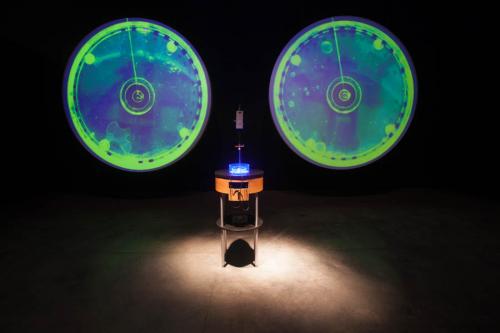
Evidence…Works by Paul Vanouse
Since the early 1990s Paul Vanouse’s artwork has addressed complex issues raised by varied new techno-sciences using these very techno-sciences as a medium. His artworks have included data collection devices that examine the ramifications of polling and categorization, genetic experiments that undermine scientific constructions of race and identity, and temporary organizations that playfully critique institutionalization and corporatization. These "Operational Fictions" are hybrid entities--simultaneously real things and fanciful representations--intended to resonate in the equally hyper-real context of the contemporary electronic landscape. In the 1990s Vanouse began to work in an arena called “BioArt.” In particular, he has been investigating the visual qualities, veracity and sociopolitical implications of DNA.
Evidence…Works by Paul Vanouse utilizes light boxes, live biological experiments, DNA electrophoresis gels, and interactive performers in the gallery to reveal varying aspects of DNA. Included in the exhibition are Suspect Inversion Center that investigates how DNA evidence was used in the O.J. Simpson murder case, and Latent Figure Protocol that uses DNA samples to create unique images. Vanouse is interested in the full spectrum of DNA––from its active process of replication to it static representation––and how it has become a fingerprint of our identity that has essentially replaced the photograph as a mirror of who we are.











